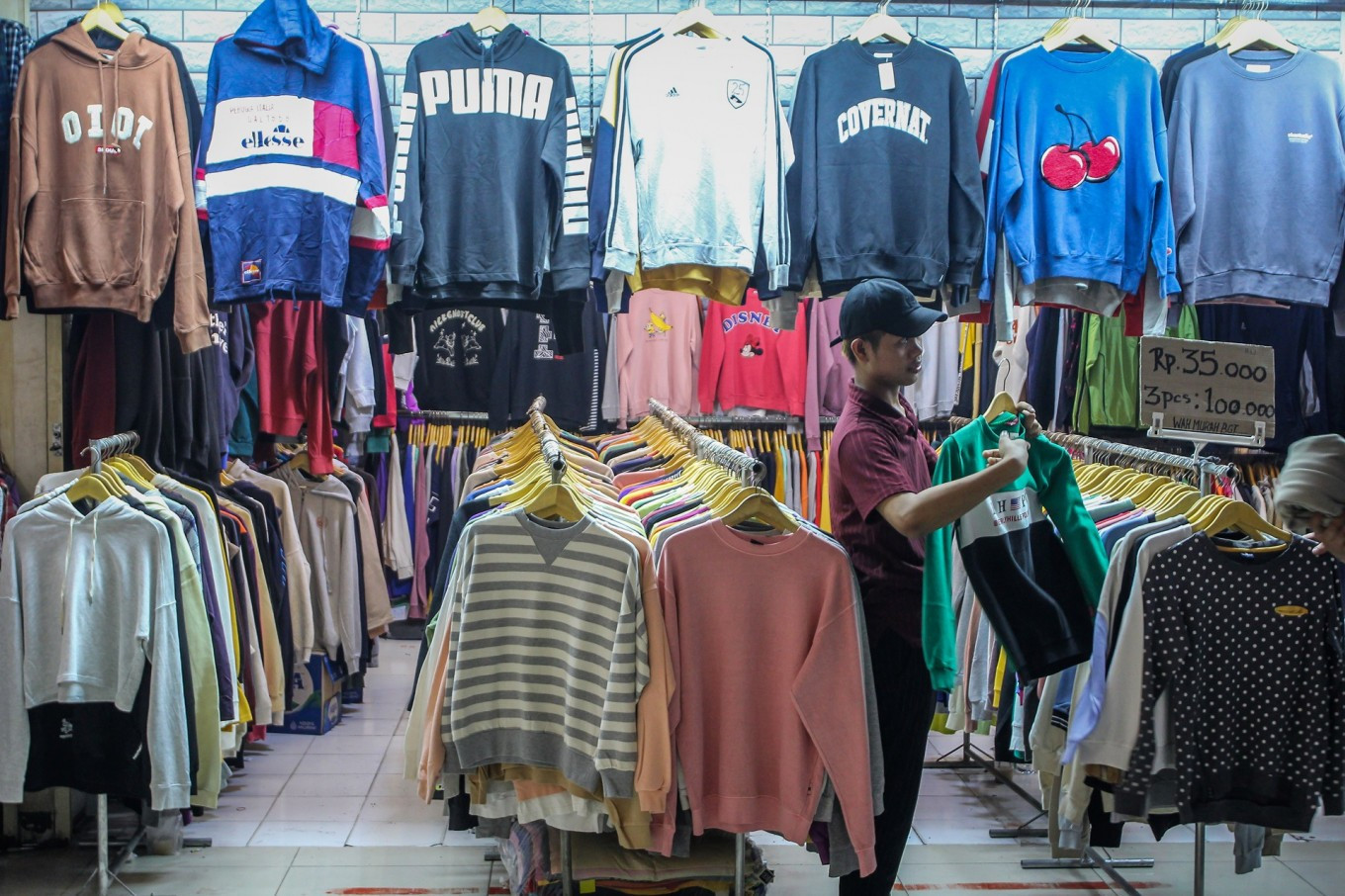News
Regulating thrift, reviving industry
Tenggara Strategics November 6, 2025 A shop attendant arranges a pullover on Oct. 24, 2025, at Senen Market in Central Jakarta. (Antara/Naufal Khoirulloh)
A shop attendant arranges a pullover on Oct. 24, 2025, at Senen Market in Central Jakarta. (Antara/Naufal Khoirulloh)
Finance Minister Purbaya Yudhi Sadewa is turning his attention to Indonesia's booming illegal thrift trade, an enduring challenge that persists despite years of government crackdowns. Thrifting is deeply rooted in Indonesian culture, not only as a fashion statement but also as a way for many to make ends meet. Yet, Purbaya's latest move signals a renewed determination to protect the domestic textile and garment industry, which continues to struggle against a flood of cheap, second-hand clothing imports.
Purbaya recently announced tighter oversight of illegal used-clothing imports. Although the trade has been officially banned under Trade Ministry Regulation No. 40/2022, thrift markets remain vibrant, exposing weak enforcement by the customs office, an institution under Purbaya's own authority. The new policy, he said, seeks not to eliminate thrifting entirely but to ensure the sustainability of local textile producers and micro, small and medium enterprises (MSMEs) in the garment sector.
The announcement has stirred mixed reactions among vendors and consumers, particularly at Jakarta's iconic Pasar Senen, where thrifting has long provided affordable and distinctive clothing options. Many sellers fear the crackdown could threaten their livelihoods. Purbaya, however, insists that the goal is not to shutter Pasar Senen but to revive Indonesia's weakened textile industry and create space for small-scale domestic producers.
The finance minister's stance has gained support from several industry associations. The Indonesian Textile Association (API) and the Indonesian Street Vendors Association (APKLI) have both welcomed the plan. API deputy chairman David Leonardi said tighter regulation would discourage illegal importers and close long-standing loopholes. He warned that the influx of second-hand imports had sharply reduced demand for locally made textiles, threatening millions of jobs. David also rejected claims that thrifted clothes offer superior quality, arguing that many are of low value and could even pose health risks to workers and consumers.
APKLI chairman Ali Mahsun echoed those concerns, noting that the surge in imported used garments has weakened sales of local products and further burdened domestic producers. While the government hopes to steer consumer demand toward Indonesian-made goods, thrift enthusiasts argue that the focus should be on stopping illegal imports rather than transforming traditional thrift markets into outlets limited to local products.
For many Indonesians, buying second-hand clothing is not merely about saving money but about finding unique, well-made items at reasonable prices. Pasar Senen's continued popularity stems from its vast selection of affordable apparel, something that local producers have struggled to match. Yet economists warn that the dominance of thrift imports carries both macroeconomic and microeconomic risks, undermining national industry and small businesses alike.
From an economic perspective, the persistence of illegal thrift imports reflects deeper structural weaknesses. The limited competitiveness of domestic textile producers, coupled with declining purchasing power, has made Indonesian consumers increasingly price-sensitive, creating fertile ground for second-hand imports to thrive. The steady flow of cheap clothing not only distorts the market but also worsens the trade imbalance, as demand for local products erodes and employment opportunities shrink.
While stricter enforcement could reduce short-term inflows, economists caution that the problem cannot be solved through regulation alone. Without revitalizing industrial capacity and stimulating middle-class consumption, the incentive to import low-cost apparel will remain. This highlights the need for a coordinated approach combining fiscal policy, industrial support and stronger consumer protection.
Weak supervision remains another key factor behind the continuing inflow of used clothing from abroad. Many shipments are believed to enter through small, poorly monitored ports. On the demand side, Indonesia's fragile economic structure, marked by income inequality and declining middle-class purchasing power, has driven consumers toward cheaper alternatives such as thrifted imports.
As the government ramps up enforcement, it faces a complex balancing act between protecting industry and preserving livelihoods. For millions of Indonesians, thrifting is not a luxury but a necessity. The government's challenge lies in tightening oversight without marginalizing small traders and low-income consumers. Success will depend on how well the state can strengthen MSMEs, improve local production quality and restore consumer confidence in domestic goods.
Beyond the fight against illegal thrifting, the issue reflects a broader test of Indonesia's economic resilience. Curbing the inflow of imported second-hand clothing is not only about border control, it is about rebuilding the competitiveness of national industries and ensuring inclusive growth. How the government manages this balance will shape the future of Indonesia's textile sector and, ultimately, its broader economic recovery.

